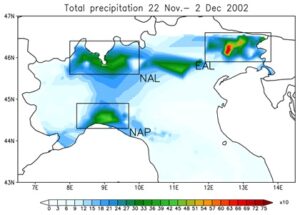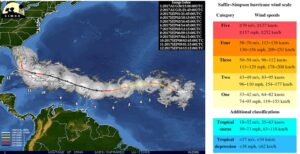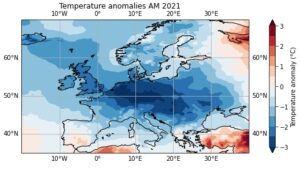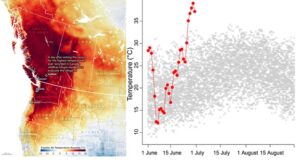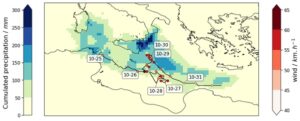Extreme precipitation France 2002
8 – 9 September 2002
This event affected the South of France during September 8th-9th, 2002, and it was characterized by the formation and evolution of a major mesoscale convective system (MCS). The event caused one of the most important flood recorded in the Cevennes-Vivarais region, with 24 people killed and economic loss estimated at 1.2 billion euros (Huet et al., 2003). The MCS was driven by a deep low pressure extending from Scotland to the western Mediterranean with an associated surface cold front. The prefrontal flow induced relatively warm and humid air into the South of France, feeding the convective system. The combination of cold temperature at mid-levels (850 hPa) and humidity at low-to-mid levels were the perfect ingredients for convection to form during the event. A further injection of wet air due to the circulation around the Southern Alps contributed to intensify the event. The maximum values of precipitation exceeded 600 mm in the region of Anduze and Alès (Delrieu et al., 2005).
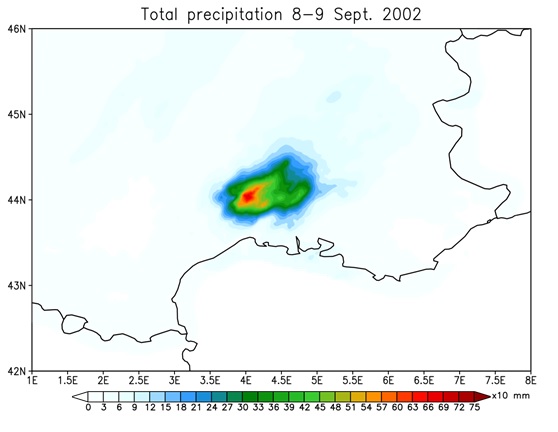
Figure1: Accumulated precipitation during the period 8-9th September 2002 from high resolution observations (Comephore, 1 km, Fumière et al. (2019), Tabary et al.(2012)); color bar unit is x10 mm.
Event definition
Given as general definition for extreme precipitation event an episode of abnormally high rain (95th percentile), the event presented here (with its rain amounts greater than 200 mm in 24 hours over and area of 5500 km2 based on Delrieu et al. (2005) and local records of 600 mm) lays at the tail of precipitation distribution for the area. The abnormal amount also reflected into the disastrous effects at ground which caused deaths and huge economic losses.
Objectives
XAIDA aims at developing an Artificial Intelligence based method to detect such kinds of events and in combination with high resolution convection permitting modeling dataset at emulating the costly dynamical models in representing them. By means of the AI methodology XAIDA will try to better understand the physical mechanisms/key factors which drive the most extreme events among the whole population of precipitating events over Europe.
XAIDA also aims to understand if such events observed in the present day period can be projected in a future climate scenario with the AI methodology and if the method can be extended to directly connect the climate variables to the observed hazard (flood) both in present and future climate conditions.
XAIDA also aims to develop an AI based method to attribute such events to climate change; the identifications of their driving mechanisms/ingredients would allow to eventually perform such attribution trough key-variables in addition to precipitation.
References
Delrieu, G., Nicol, J., Yates, E., Kirstetter, P., Creutin, J., Anquetin, S., Obled, C., Saulnier, G., Ducrocq, V., Gaume, E., Payrastre, O., Andrieu, H., Ayral, P., Bouvier, C., Neppel, L., Livet, M., Lang, M., du-Châtelet, J. P., Walpersdorf, A., & Wobrock, W. (2005). The Catastrophic Flash-Flood Event of 8–9 September 2002 in the Gard Region, France: A First Case Study for the Cévennes–Vivarais Mediterranean Hydrometeorological Observatory, Journal of Hydrometeorology, 6(1), 34-52.
Huet, P., Martin, X., Prime, J.-L., Foin, P., Laurain, C., and Cannard, P.: Retour d’exp erience des crues de spetembre 2002 dans les departements du Gard, de l’Herault, du Vaucluse, des Bouches-du-Rhone, de l’Ardeche et de la Drome. (In French), Tech. rep., Ministere de l’ecologie et du developpement durable, Republique Francaise, 2003
Fumière Q, Déqué M, Nuissier O, Somot S, Alias A, Caillaud C, Laurantin O, Seity Y (2019) Extreme rainfall in Mediterranean France during the fall: added-value of the CNRM-AROME Convection-Permitting Regional Climate Model. Clim Dyn. https:// doi.org/10.1007/s00382-019-04898-8)
Tabary P, Dupuy P, L’Henaff G et al (2012) A 10-year (1997–2006) reanalysis of quantitative precipitation estimation over France: methodology and first results. IAHS Publ. 351:255–260
 This project has received funding from the European Union’s Horizon 2020 research and innovation programme under grant agreement No 101003469.
This project has received funding from the European Union’s Horizon 2020 research and innovation programme under grant agreement No 101003469.

